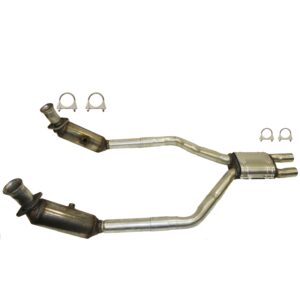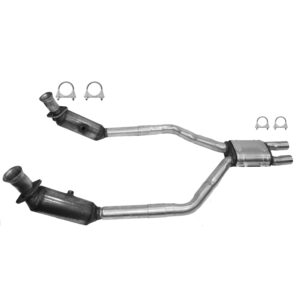About Catalytic Converter
A catalytic converter is an emissions control device that reduces toxic gases and pollutants in exhaust gas from an internal combustion engine into less-toxic pollutants by catalyzing a redox reaction (oxidation or reduction). It typically contains a ceramic or metal substrate coated with a catalyst such as platinum, palladium, and rhodium.
The catalytic converter works by converting harmful pollutants like nitrogen oxides (NOx), carbon monoxide (CO), and hydrocarbons (HC) into less harmful substances like nitrogen, carbon dioxide, and water vapor through a series of chemical reactions. These reactions occur at high temperatures, typically ranging from 400°C to 800°C (750°F to 1470°F), which is why the converter is usually positioned close to the engine where exhaust gases are hottest.
Since the 1970s, catalytic converters have been an essential component in vehicles to meet emission standards and reduce air pollution. They are found in most gasoline and diesel vehicles, including cars, trucks, buses, and motorcycles.
However, catalytic converters can also be targets for theft due to the valuable metals they contain. To mitigate this issue, some countries have implemented regulations requiring serial numbers on converters or have restricted the sale of used converters to licensed recyclers.
What is the function of the catalytic converter?
The primary function of a catalytic converter is to reduce the harmful emissions produced by internal combustion engines. It achieves this by facilitating chemical reactions that convert toxic pollutants in exhaust gases into less harmful substances before they are released into the atmosphere.
Here’s a breakdown of its key functions:
- Reduction of Nitrogen Oxides (NOx): Nitrogen oxides are pollutants that contribute to smog formation and acid rain. The catalytic converter helps to reduce NOx emissions by catalyzing reactions that convert them into nitrogen and oxygen gases.
- Oxidation of Carbon Monoxide (CO): Carbon monoxide is a poisonous gas that forms when carbon-containing fuels are not burned completely. The catalytic converter promotes the oxidation of CO into carbon dioxide (CO2), a less harmful greenhouse gas.
- Oxidation of Hydrocarbons (HC): Hydrocarbons are unburned or partially burned fuel molecules that contribute to smog formation. The catalytic converter facilitates the oxidation of hydrocarbons into carbon dioxide and water vapor.
The catalytic converter plays a crucial role in reducing vehicle emissions to meet environmental regulations and improve air quality.
















